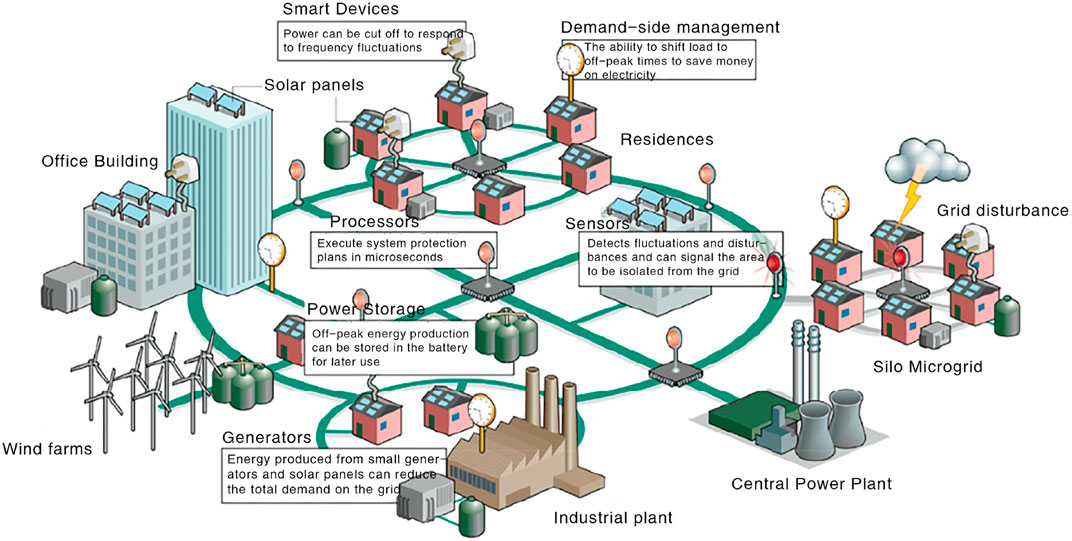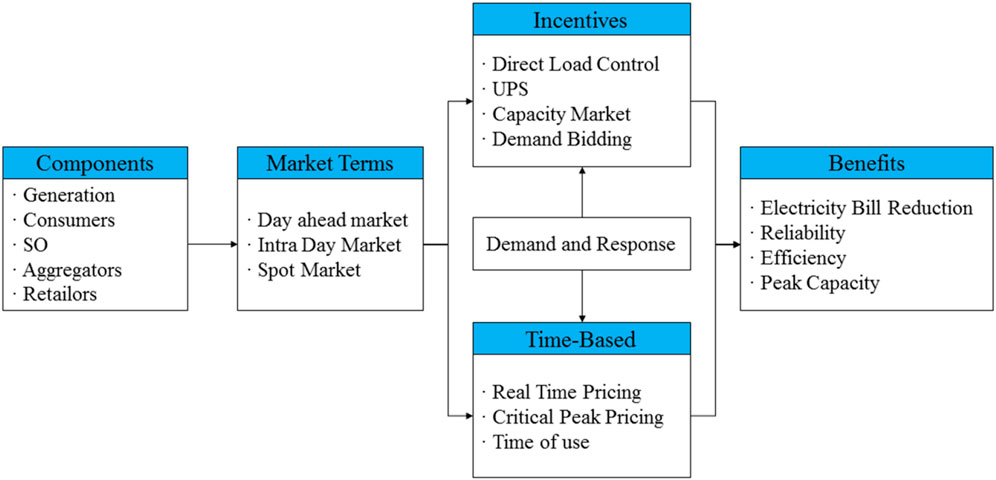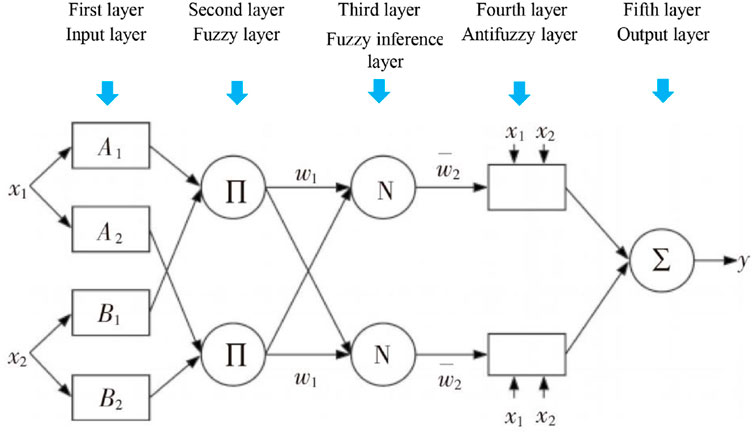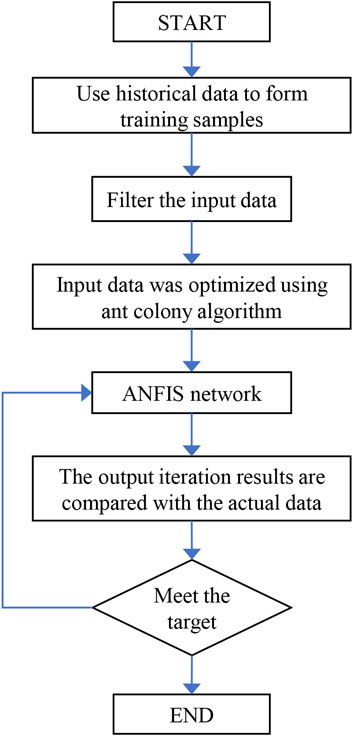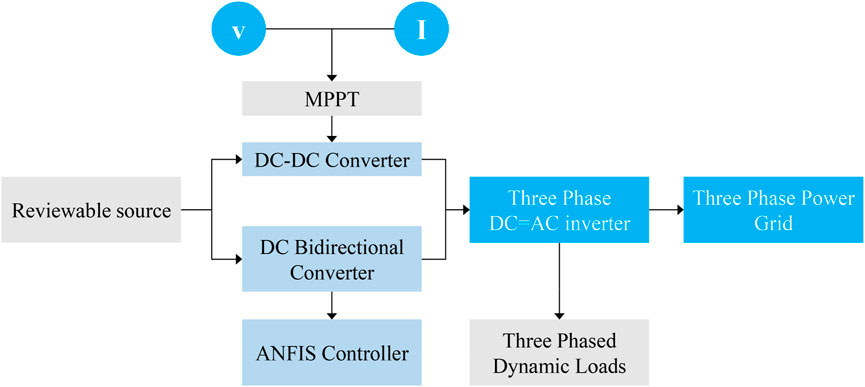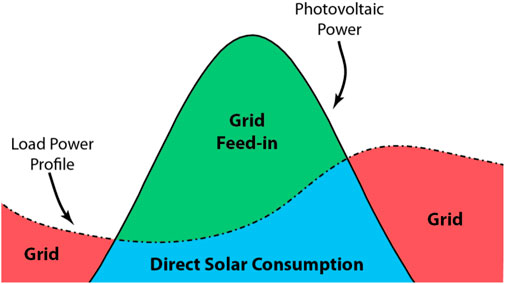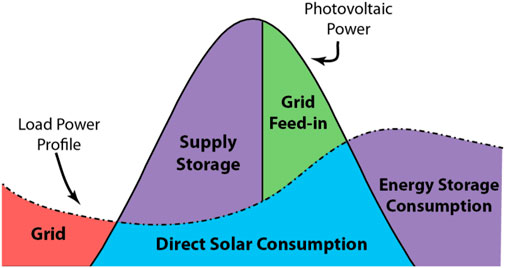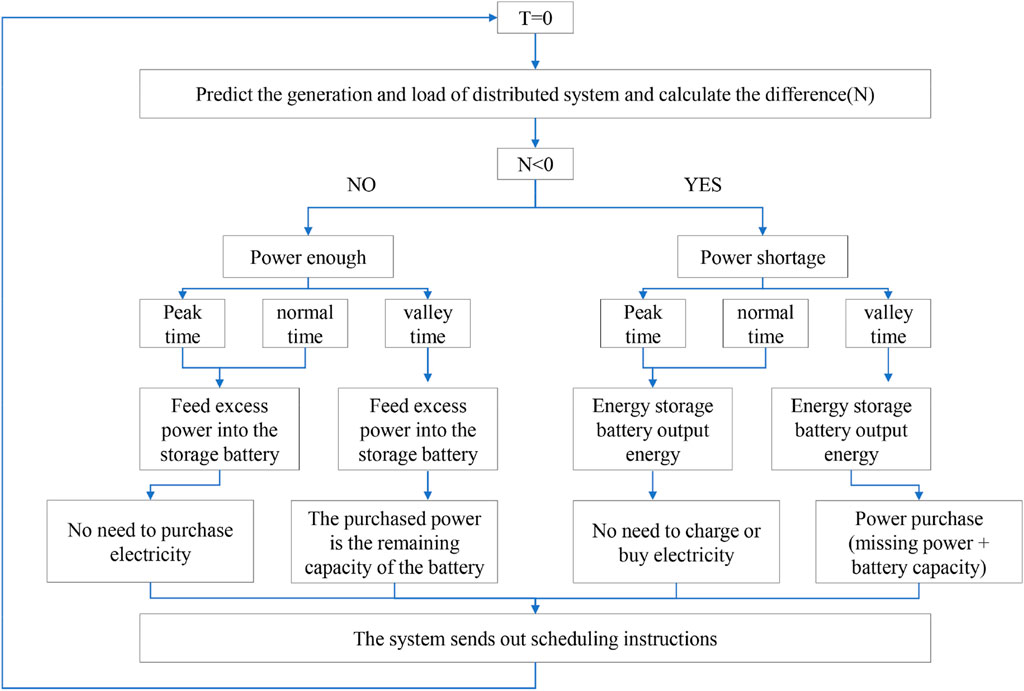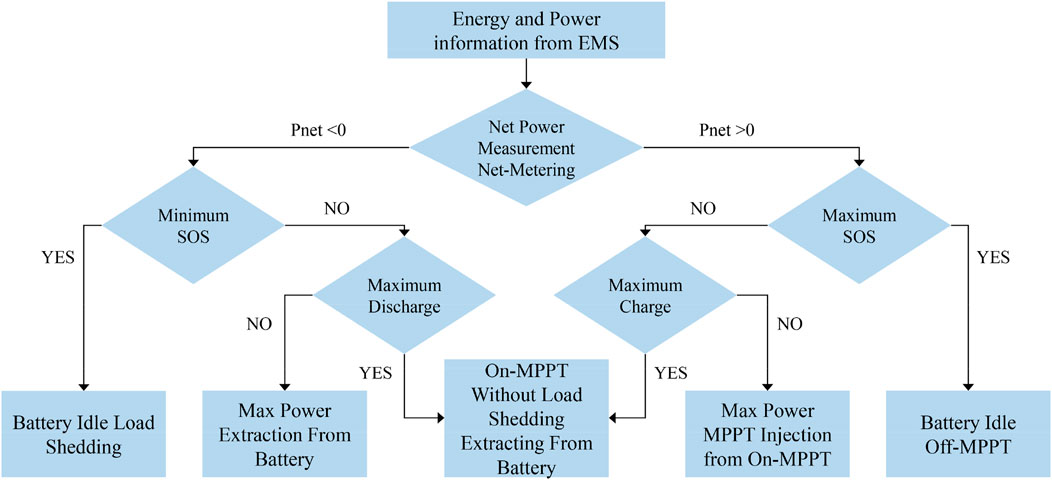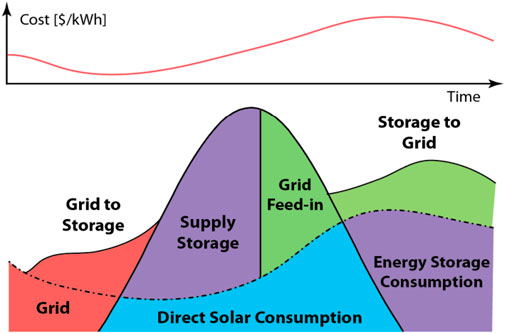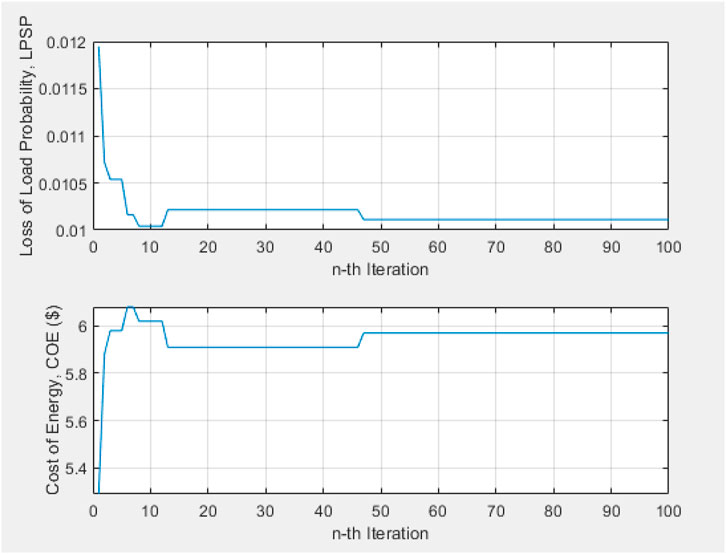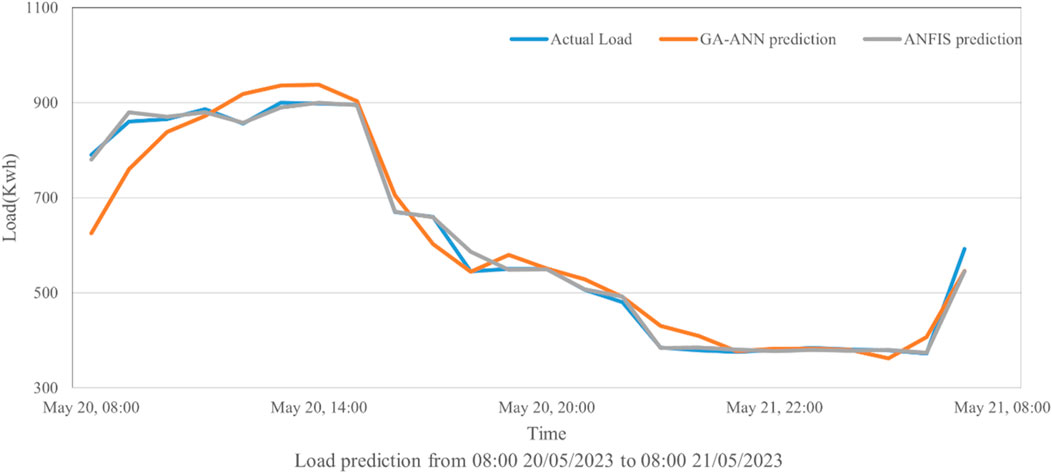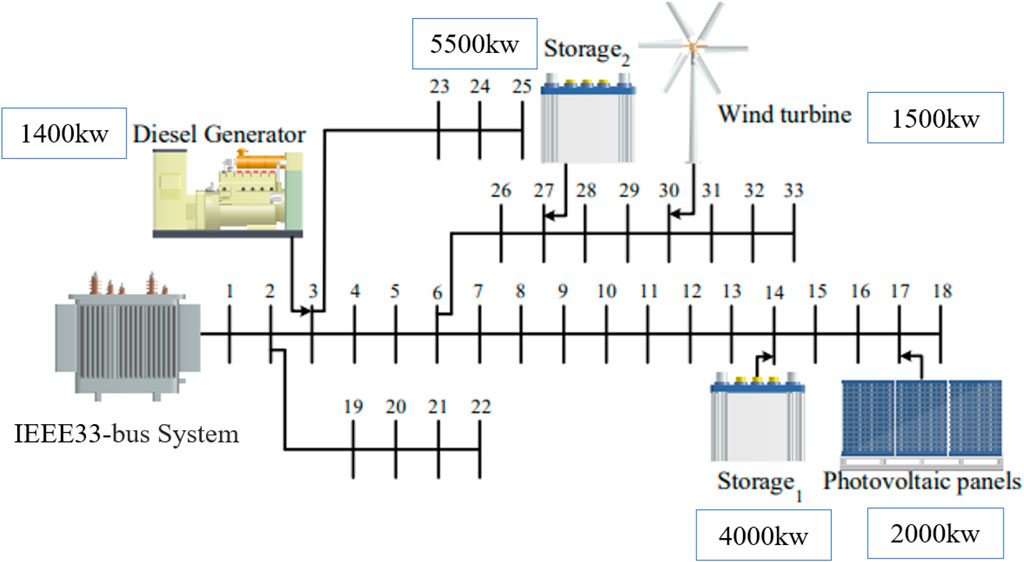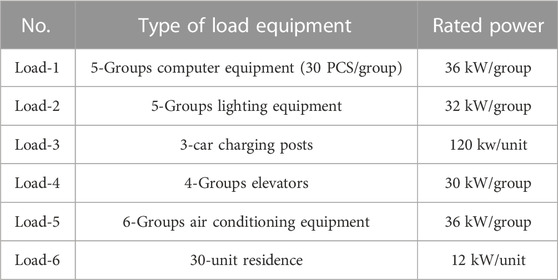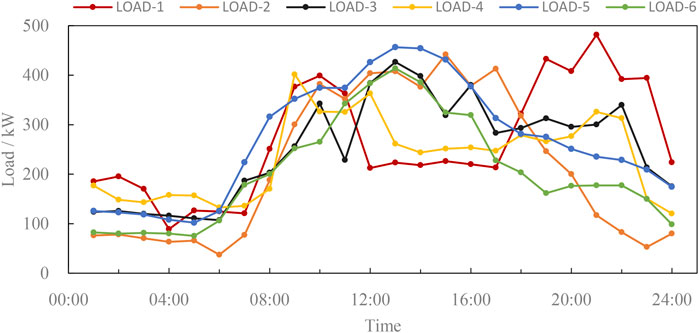- 1Shaanxi Provincial Land Engineering Construction Group Co., Ltd., Xi’an, Shaanxi, China
- 2Shaanxi Dijian Real Estate Development Group Co., Ltd., Xi’an, Shaanxi, China
- 3School of Architecture, Xi’an University of Architecture and Technology, Xi’an, China
- 4Ural Institution, North China University of Water Resources and Electric Power, Zhengzhou, China
Power generation and transmission infrastructure is vulnerable to the interaction of various Distributed Generations (DG), which leads to the imbalance of power system operation, frequent voltage drops or spikes, and even power outages. This phenomenon not only wastes energy, but also affects grid security. The main reason is a delayed feedback of circuit failure and load changes, and the optimization of energy management system and path is an effective way to solve the above problems. In this paper, a method of multi-objective optimization based on ANFIS algorithm is proposed which can help to improve the demand response, energy storage and management of smart power grid, reduce the volatility of DGs, reducing electricity costs and improving energy efficiency. Firstly, based on the ANFIS algorithm, the distributed power generation control mode, inverter control, real-time electricity price calculation method, energy transfer and storage scheme are improved, and the optimization path of the energy management system is defined. Secondly, the advantages of ANFIS algorithm in response speed and running stability are verified by comparing with other algorithms. Finally, a distributed energy microgrid is constructed for simulation verification. The results show that :(1) ANFIS optimization algorithm has good adaptability in smart grid, and has advantages in large amount of data processing and information transmission; (2) The verification model based on ANFIS has strong elasticity and efficient response speed. The research results will help solve various problems in the smart grid, including establishing a clear energy management system path, maintaining the stable operation of the power system, providing users with more reasonable power plans and the lowest cost of electricity.
1 Introduction
Smart grid uses advanced sensing, measurement, communication, control, and other technologies to achieve flexible, efficient, safe and reliable, and green economic integrated goals of power generation, transmission, distribution, and electricity consumption (Marris, 2008), and has become the main direction for future development. (as shown in Figure 1). However, with the uncertainty of user distribution, the problems of long-distance power transport loss (Kamruzzaman, 2021), low conversion rate of traditional power supply, and inflexible power supply leading to high electricity costs began to become prominent. At present, all countries in the world are facing the pressure of reducing carbon emissions (Granado et al., 2020), and the types of distributed energy resources (DER) have increased greatly, for example, renewable energy sources (RES), battery energy storage systems (BESS), photovoltaic (PV), wind turbines and other new distributed energy (Ding et al., 2022; Wang et al., 2023); New energy vehicles (EV), intelligent buildings and other new electricity units (Zielińska, 2020). Smart Grid Framework 4.0 (Gopstein et al., 2020) will undoubtedly rely on distributed energy resources to meet low energy consumption expectations and achieve the global target of 42% renewable energy generation (U.S. Energy Information Administration, 2021). Based on the above background, both supply and demand sides of the smart grid show the characteristics of diversity, intermittence, randomness, and flexibility. Rapid demand response, system stability, flexible power supply mode, and reduced electricity costs are the main development directions of smart grid in the future (Ghiasi et al., 2018; Akbary et al., 2019; Mohammad et al., 2023).
However, due to the unpredictable nature of distributed energy resources, it can significantly alter the voltage curve of the grid system and hinder the performance of traditional on-load tap switch control systems, which poses risks to the operation of a smart grid (Marchi et al., 2019). As a result of the forced use of these technologies, problems such as reduced power quality, energy imbalances, reduced operational reliability, reduced system security, and regulatory concerns (including unfair distribution of benefits to customers) have arisen (Zhang et al., 2021). As an important part of a smart grid, an intelligent power distribution system is confronted with many challenges in the process of energy development, such as energy resource limitation, renewable energy generation uncertainty, multi-energy flow coupling complexity, and privacy information security (Madhuri et al., 2022; Dzobo et al., 2021). Adopting a more efficient operation algorithm and energy management strategy is the key to ensuring the economic and efficient operation of an intelligent power distribution system under distributed power supply.
For a long time, a large number of studies have tried to figure out how to achieve low-cost, high-efficiency, and stable energy management in smart grids. An energy management system (EMS) is “a computer system comprising a software platform that provides essential support services and a set of applications that provide the functions required for the efficient operation of power generation and transmission facilities to ensure the security of energy supply at the lowest cost” (IEC 61970) (Arcos-Aviles et al., 2018; Gan et al., 2018; Hussain et al., 2019) (Figure 2). In order to solve the problems brought by DER, it is necessary to change the traditional passive distribution mode (Martinez et al., 2017) into active distribution mode. In addition, it is also necessary to change the transfer and storage mode of energy (Ali et al., 2021), solve the load fluctuation caused by DER to the power system, reduce the severity of some negative problems, and improve the stability and reliability of the power system load. At present, there are many research directions on EMS.
Reasonable energy management system is the basic framework to solve the above problems. The construction of a real-time demand response framework (Yu et al., 2020) can effectively alleviate the periodic fluctuations of the power grid, not only reduce the peak demand of users and the power generation cost of the power supplier but also save the electricity cost of residential users and increase social welfare. Nowadays, in order to better deal with energy scheduling and management problems, many optimization strategies are proposed and implemented. For example, in order to reduce the cost of energy use, Ref. (Adam et al., 2022; Martins et al., 2022). proposes an energy management method based on mixed integer linear programming (MILP) and establishes a power management strategy suitable for RES by optimizing the operating system. In order to ensure stable energy transmission and sharing, Ref. (Fagundes et al., 2022). proposes a coordinated and decentralized control structure of DC microgrid (MG) powered by fuel cells (FC) and energy storage units (ESUs), which realizes energy sharing and transmission under stable state through complementary behavior under the fuzzy controller. In order to enhance the elasticity of SGs and MGs, Ref. (Ghiasi et al., 2023). proposed a variety of schemes to improve the elasticity of networks of cyber-physical systems (CPS) in the system design stage. In the process of reducing electricity costs, reducing energy waste, and maintaining SG stability, the quick feedback and judgment of information play a key role in EMS. A correct algorithm can improve the efficiency of the system.
In order to make the smart grid meet the needs of different scenarios, different optimization algorithms are used in different links of the power grid system. Ref. (Shi et al., 2023). presents an enhanced biogeography-driven optimization algorithm for optimizing the operations and sizes of battery ESSs (BESSs). Particle swarm optimization (PSO) is often used to optimize SG systems. For example, Ref. (Ghiasi, 2018). proposed an optimal design scheme of intelligent microgrid based on multi-objective particle swarm optimization (MOPSO) hybrid RESs. Ref. (Mahdi et al., 2018). proposed a quantum-inspired particle swarm optimization (QPSO) technique to solve the multi-objective environmental economic scheduling (EED) problem. In addition, Ref. (Ghiasi et al., 2021). proposed an improved multi-objective differential evolution (IMODE) optimization algorithm, and applies it to the multi-operation energy management form of intelligent smart microgrid (MG) system. These different optimization methods help build more efficient energy management systems. At present, the energy management system of the smart grid mainly faces threats from unstable distributed energy and harsh environment. The key to solving this problem is how to deal with load fluctuation and load prediction quickly.
The load prediction of SG involves many factors and has fuzziness and nonlinearity, so it is difficult to establish an accurate mathematical model. ANFIS has the fuzzy processing capabilities of complex factors and adaptive learning solutions, which are especially suitable for complex load prediction. Ref. (Panagiotou and Dounis, 2022). compared artificial neural networks, adaptive neural fuzzy reasoning systems (ANFIS), and long-short term memory (LSTM) as three load forecasting methods. ANFIS is superior to all other models and can deal with complex nonlinear problems well. Ref. (Ghenai et al., 2022). proved the ability of the ANFIS model to predict power load quickly, and verified the accuracy and reliability of the model in microgrid power systems. Ref. (Bilgundi Srishail et al., 2022). proposed a PI current controller optimized by ANFIS, which can improve the control of DG. Ref (Gupta et al., 2020) designed a multi-objective inverter based on an ANFIS controller and an overall power management strategy to manage the power transmission between RES, loads, and the grid.
The applicability of ANFIS in energy management systems has been proven. At present, there are still some functional defects in the construction of a smart grid. For example, the construction of terminal power metering, severe weather warning, two-way communication, and other systems is still not perfect. The construction of a smart grid system requires efficient collaboration among various supporting equipment. Therefore, the optimization method of ANFIS in a multi-factor coupled environment needs further study. A multi-objective optimization method of ANFIS based on an ant colony algorithm is proposed in this paper. The rest of this paper is organized as follows: Section 2.0 introduces the research methods and theories; Section 3.0 introduces the system optimization methods of DGs utilization and management, inverter control, power cost control, and other links, and makes a detailed energy scheduling strategy. Section 4.0 discusses the rapid response capability of ANFIS and the accuracy of load prediction of different algorithms. Section 5.0 discusses the shortcomings of the research and the applicable scenarios. Finally, the conclusion is given in Section 6.0. The goal of the energy management strategy is to improve energy management efficiency, information accuracy and reduce electricity costs by optimizing DGs and energy scheduling.
2 Methodology
2.1 ANFIS model and DGs load prediction method
ANFIS was proposed by scholar Jang Roger in 1993 (Jang, 1993), which combines fuzzy theory and neural networks organically. On the one hand, the fuzzy system can be used to solve the problem of complex nonlinear prediction models, and the fuzzy processing of some complex factors can improve prediction accuracy. On the other hand, the adaptive membership function of the fuzzy system is constructed by using the information storage ability and learning ability of the neural network, so as to construct the nonlinear mapping relationship between input and output which can approximate complex solving problems. Compared with other neural fuzzy systems, ANFIS is convenient and efficient, and is particularly suitable for complex distributed power grid load prediction (Leonori et al., 2019). The typical ANFIS structure is shown in Figure 3, which consists of five layers: Input layer, Fuzzy layer, Fuzzy inference layer, Anti-fuzzy layer, and Output layer.
It is generally acknowledged that the load variation in DGs is nonlinear, and it is difficult to express its main change mode by a single linear model. However, ANFIS utilizes the dual characteristics of fuzzy algorithms and neural networks, which is conducive to solving this complex problem. In the ANFIS structure and approach, the key indicator is the input variable of the model, which needs to be determined in conjunction with the actual problem. Specific methods and steps are as follows.
(1) The first step is to determine the input variables and attribution functions required to solve the problem. In this system, the load varies greatly with the different seasons and the number of equipment outside the system, and this variability has certain rules to follow. However, under the premise of large rules, the specific data at every moment is affected by various factors. Therefore, when constructing an ANFIS input set, the system needs various data for learning and training.
(2) The second step is to use the function to train ANFIS to get the predicted value.
(3) The third step is to validate the ANFID-generated values with real-world data to generate the prediction model.
In this study, the advantages of ANFIS were utilized to optimize the energy management system with multiple objectives to achieve the following goals: 1) Try to enhance the elasticity of the power system and ensure the stability of the power system by optimizing the functions of photovoltaic, wind and battery energy systems under different Settings (controlled by ANFIS, adaptive controller and battery respectively); 2) The overall optimization scheme will consider the comprehensive benefits of multiple related objectives, not limited to the benefits of a single objective; 3) Enhance the elasticity and power quality of the power grid, and reduce the risk caused by random factors such as rain, load reduction, and bad weather.
2.2 ANFIS parameter optimization method
The training process of ANFIS generally adopts a mixed learning algorithm, which includes forward and backward processes (Sowinski, 2021). In this process, the accuracy of input parameters in ANFIS is the key to solving the problem, so taking a certain way to optimize the parameters is a prerequisite for a more accurate prediction model. To further improve the accuracy of prediction, this paper uses an ant colony algorithm to correct the input data (Ogunsina et al., 2021). The basic principle of the ant colony algorithm is to make use of the relationship between the independent behavior of a single ant and the group restriction to carry out a process of continuous iteration, and then make the group’s actions gradually accurate. Therefore, the ant colony algorithm is an intelligent behavior constructed by simple cooperation between ants to obtain the optimal solution process. After optimizing input parameters by the ant colony algorithm, these parameters can be used to train the ANFIS network, find out the hidden relationship between input and output values of distributed load based on smart grid, and form these parameter values into training data for accuracy correction, so as to form an ideal model. Finally, the actual data can be used as input data for model calculation, and then realize the calculation of the corresponding load. The flow chart is shown in Figure 4.
3 Models and methods
3.1 DGs network management ANFIS control scheme
The intelligent management mode of DGs plays a positive role in improving the stability of power systems, power quality, and power generation efficiency. DGs in grid-connected and island modes are often affected by extreme weather and elastic demand. Although the traditional FCL control mode can deal with nonlinearity, it has low operating efficiency and difficulty in obtaining clustering conclusions when the computation is large. ANFIS can optimize FLC membership functions and rules for better performance (Nafeh Abdelnasser et al., 2022). ANFIS (FLC) has high computation speed, a high probability of convergence to the global optimal solution, and obvious computational advantages for multi-load systems. In smart grids, each component (Sun, wind, battery, load, etc.) is critical to the overall operation. In this paper, the smart grid control system is optimized by improving the control mode and improving the operation efficiency of DGs: 1) A new operating mode based on ANFIS control is used to control solar power generation, wind power generation, and supercapacitor power generation in DGs. 2) Using ANFIS to optimize photovoltaic maximum power point tracking technology and improve solar energy utilization efficiency.
The new control mode will improve emergency, energy-saving, and regular modes: 1) A bidirectional converter keeps the DC connection and allows power to flow in both directions, satisfying both the source and the sink. 2) The intelligent system relies on the ANFIS algorithm to calculate the power demand of the system and control the energy acquisition and output of DGs. It can improve power management by optimizing power factors and automatic identification/switching of the network. Under this mode, DGs will reduce battery loss or overcharging and improve battery life and power system performance. The control strategy is as follows (Figure 5).
(1) If both solar and wind power generation are between 0% and 30% (NL), the system will switch to emergency mode. (NL)
(2) If the combined solar and wind output is less than 30% (NL) or 30%–60% M), an emergency mode will be engaged (NL)
(3) When the percentage of renewable energy sources is between 0% and 30% (NL) or 60% and 100% (PL), the energy savings mode kicks in M)
(4) When solar output is poor and wind speeds are low (NL), emergency mode kicks in (NL)
(5) Power conservation kicks in when the combined capacity of solar and wind is between 30% and 60%. M)
(6) The PL is in the typical range when there is 30%–60% sunshine and 60%–100% wind (PL)
(7) In the range of 30%–60% (NL) of total energy production from solar and wind, energy conservation mode kicks in M)
(8) When the amount of solar energy is between 60% and 100% and the amount of wind energy is between 30% and 60%, normal operation is initiated (PL)
(9) Once the combined output of solar and wind energy reaches 60%–100% (PL), normal operation is achieved (PL)
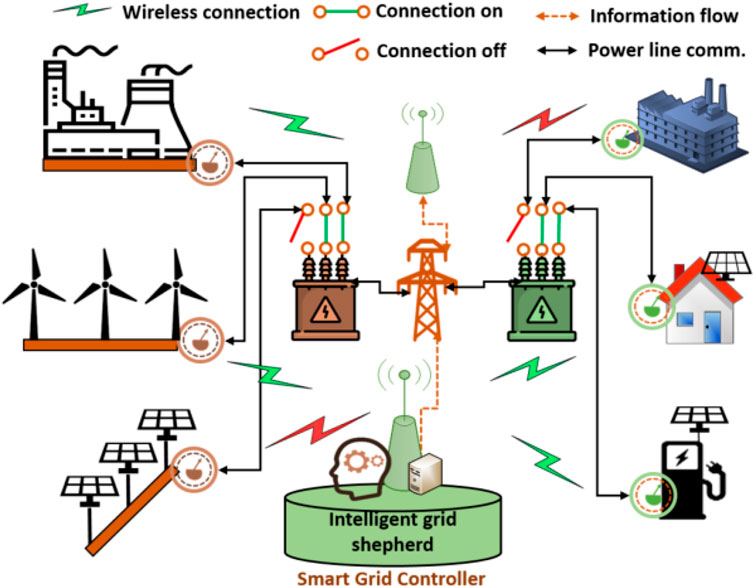
FIGURE 5. A system model for resilient distributed energy resources control system in a smart grid framework.
Photovoltaic maximum power point tracking (MPPT) technology is an important way to effectively utilize solar energy. In this paper, adaptive neuro-fuzzy interface systems (ANFIS) are used to replace the traditional fuzzy logic controllers (FLC). Since ANFIS does not necessitate an exact mathematical model, it is inputs are variable. The ANFIS have three separate steps: fuzzification, rule-based database lookup, and defuzzification. In fuzzification, membership functions are used to translate quantitative inputs into qualitative ones expressed in human-understood language. It is common for the MPPT ANFIS to accept either the error E) or its evolution (E′) as an input. At the outset of the ANFIS input procedure, error E) and delta-E are determined (CE). It is common knowledge that the duty ratio (represented by the modification of the duty cycle D)) at FLC outputs varies. The workflow is shown in Figure 6.
3.2 Inverter ANFIS control scheme
Modern power grids connect a large number of nonlinear loads and various types of DGs, resulting in continuous changes in grid frequency (Bilgundi et al., 2022). The adaptive intelligent nonlinear controller can solve the influence of frequency change, voltage distortion, and nonlinear load at the same time, and enhance the power quality of the grid. The basic function of the inverter is to convert the direct current (DC) to alternating current (AC), safely and reliably connecting solar panels to the power grid. In this paper, fuzzy logic controller (FLC) and adaptive neural fuzzy inference system (ANFIS) are proposed to control voltage. These controllers help keep the output voltage constant even when the inverter input voltage changes. The controller can control power network fluctuation mainly by monitoring voltage deviation. In this model, the voltage deviation is obtained by calculation (divide the observed d-q current value after the Park transformation by the expected value e. k)). If the deviation is too large, ANFIS (FLC) is immediately notified to adjust the current in the device (the current in the d and q directions is controlled by the two FCLS respectively). To synchronize with the initial frequency of the grid, the node uses a phase-locked loop (PLL). The inverter receives and controls voltage from the controller via a pulse width modulation (PWM) block (Muralikumar and Ponnambalam, 2021). Figure 7 describes the inverter control scheme based on ANFIS (FLC).
In this scheme, the properties of ANFIS themselves (fuzzy theory and neural network) are superior to previous fuzzy derivation techniques. ANFIS is used because it allows fuzzy systems to learn from the data they represent (by adjusting membership function parameters). The input and output information of FLC is used to train and verify the ANFIS model and improve the overall performance of the controller. The control scheme shown in Figure 7 can dynamically control the inverter to inject/absorb the appropriate power to regulate the voltage of the grid system and provide a robust response to any system worst-case and grid failure.
3.3 Energy storage and scheduling strategy
Facing the unstable and uncontrolled characteristics of RES, the development of an energy storage mode can make up for the shortage of new energy power generation and realize energy transfer through peak cutting and valley filling (Qinglai et al., 2017). Therefore, it is of great significance to study the comprehensive energy management system under the mode of “new energy + storage”.
In the electricity system, there are many traditional energy storage methods, such as pumped storage, electrochemical energy storage (fuel cells), thermal energy storage, supercapacitor energy storage, and so on. Electrochemical storage (fuel cell) and thermal storage (fluids) are used more frequently than any other combination of storage methods in photovoltaic (PV) facilities and concentrated solar power (CSP) plants, respectively (Liu and Du, 2020). The production of solar energy is less reliable than that of fossil fuels and other forms of energy. Depending on the local climate, it may change with the seasons and even throughout the course of a single day. Thus, unnecessary energy waste and power system security problems are caused. Figure 8 shows the changes in the relationship diagram between photovoltaic power and energy utilization in a power system.
Figure 8 visually shows the difference between energy load and energy supply. The impact at a particular time (peak load) can be mitigated if larger energy loads can be delayed or predicted until the power system is ready to accommodate additional demand. For example: Time Shift is an online store that offers several different types of energy storage solutions, including residential and commercial energy storage. For businesses and factories, Time Shift has energy storage options. Peak shaving is one of the most exciting uses of Energy Storage for the future of the smart grid. Peak shaving is a method of managing rapidly fluctuating demand that helps keep peak capacity from being over-provisioned. Peak Demand Shift with Energy Storage is depicted in Figure 9. In this process, through the analysis of the structural characteristics of the integrated energy system, the photovoltaic, fan, CHP, and energy storage battery in the power grid system are the normal dispatching objects in the power system, and provide power supply for the system. According to the power generation characteristics and power load characteristics of distributed energy, detailed energy scheduling strategies are formulated, as shown in Figure 10.
3.4 Implementation of energy management logic
In order to reduce the output fluctuation of fan and photovoltaic caused by environmental factors, improve the absorption rate of distributed renewable energy, reduce the pollution emission caused by diesel generators, coordinate the output of various power generation technologies, and ensure the stability and economy of the system operation, it is necessary to develop flexible and reliable energy systems and efficient and intelligent scheduling strategies. The goal of this approach is to supply the load with enough energy while limiting its reliance on the grid. The model is also supposed to supply the load with energy generated by renewable resources like solar panels, batteries, fuel cells, and windmills. The ANFIS-optimized energy management system model is depicted in Figure 11. In this model, an energy storage component control method considering demand response is proposed. According to the real-time power demand measurement results, the operation state and energy storage mode of DGs are controlled.
3.5 Variable electricity cost optimization method
Under a variable energy tariff, your energy provider has complete control over the per-unit gas and electricity rates you’ll be charged. In most cases, early termination fees are not applied, and the parameters of a contract with a variable interest rate are more negotiable. The price of electricity might change several times in a single minute. However, most consumers have seasonal price changes in their electricity bills. Also included are fuel prices and the number of DGs operating, which tend to cause fluctuations in electricity prices. However, most consumers have seasonal price changes in their electricity bills. Also included are fuel prices and the number of DGs operating, which tend to cause fluctuations in electricity prices. Electricity usage costs also depend on the type of customer. For example, utility customers often have fixed electricity bills because they have to pay them at all times. However, the randomness of residential electricity consumption is large, and the dominant power of the customer is the main factor. Therefore, making a reasonable energy scheduling strategy according to energy production and load changes can effectively reduce the cost of electricity.
Figure 12 shows the cost of electricity as a function of energy supply. When the energy supply is sufficient but the load of the grid is low, the cost of electricity in the period of high load can be reduced through energy storage and transfer. Therefore, peak transfer is an effective way to reduce electricity costs. This paper calculates the most reasonable electricity price through ANFIS optimization.
The goal of this method is to reduce the consumer’s international electricity bill the following day. By imposing the following constraints, we can calculate the optimal residential power pricing for time period T. It is possible to demonstrate that Formula-(1): The overall cost of consuming power with a changeable price can be reduced by:
Where C is the grid’s total charge and E is the sum of the energies of all k-intervals up to N-timescales. Both the amount of energy going into and out of the battery, and the equilibrium between the two, will be limits. The notation for constraint a) is Formula-(2), whereas that for b) is Formula-(3). In addition, according to the change in energy supply and the load of the grid, Formula-(4) also gives the change function of electricity price T).
3.6 Linear program-based ANFIS optimization
When a mathematical model’s needs are expressed as linear relationships, the ANFIS optimization technique of linear programming can be used to maximise (or minimise) an objective function. The goal of linear programming is to determine what values can be assigned to the variables so as to maximise or minimise the objective function. Linear programmes (LPs) typically take the following standard structure, as seen in Formula- (5):
The optimization of the LP ANFIS requires a specific set of states, denoted by x.
Equivalent constraints are given as:
Inequivalent constraints are given as:
3.7 Evaluation metrics
The system will be evaluated on the following metrics.
(1) loss of power supply probability (LPSP)
The loss of power supply probability (LPSP) is a statistic that indicates how likely it is that the PV and energy storage system will fail to provide the associated load in the case of a power failure. It is a great tool for testing the system’s responsiveness under both known and hypothetical loads.
(2) cost of electricity
The total cost of running an appliance is calculated by multiplying the tariff rate (say 20 cents/kWh) by the item’s electricity consumption (kWh) (in dollars). Multiply the appliance’s kW or W output by the number of hours you use it to get its kWh consumption.
4 Results
Considering the factors of system stability and electricity cost, the above contents provide energy management paths and system optimization methods for different links in EMS. Through the above methods, the main objectives are: 1) Through the optimization of linear ANFIS, achieve fast feedback of multiple load management and low cost of flexible power consumption; 2) Balance the supply and demand relationship between the two ends of the smart grid through rational energy distribution, reduce the risk of power grid interruption, so as to realize the stable operation of the power grid. ANFIS is used to optimize the power grid system, mainly to improve the response speed, enhance the robustness of the power system, and the accuracy of the power grid load prediction. Next, this paper will verify the feasibility of ANFIS to achieve the above goals in some cases.
4.1 Load management using ANFIS optimization
There are a series of constraints in the optimization between energy management and demand response of smart grids, so the method based on optimization theory is often used to solve this problem. ANFIS optimization algorithm obtains global information by communicating with neighbors without the need for a centrally scheduled CPU, thus greatly reducing network communication and computing burden. Therefore, compared with the centralized optimization algorithm, the ANFIS optimization algorithm has huge advantages in terms of computation, operation cost, scalability, and so on. It can be used to solve large-scale optimization problems which are difficult for centralized algorithms.
A swarm of particles finding the best answers to problems in computational science via ANFIS optimization requires iteratively improving the quality of potential solutions. The linear ANFIS optimization algorithm is based on the principle of iteratively improving candidate solutions in computer problem-solving. Recently, it has been found that ANFIS optimization can be carried out with less complicated algorithms. In order to reduce power usage on a regional or national scale, demand-side management (DSM) is an integral part of a smart grid energy management system. As part of energy management for smart grids, this study investigates a novel approach to demand-side load shifting. Figure 13 shows an actual example of an iterative process through ANFIS optimization. Through the optimization of evaluation indicators (Cost and LPSP), optimization results can be obtained through fewer iterations in a short time, and a good load management effect is obtained.
With this method, consumption curves can be optimized for customers in the residential, commercial, and industrial markets. The ANFIS algorithm can prioritize and schedule loads based on user preferences, keeping costs to a minimum. One of the many benefits of this demand-side management (DSM) is reduced electricity consumption and lower energy waste; The other is that low-cost, variable models encourage more new customers to join the grid. Increased demand from household appliances and individual consumers can contribute to the sustainable development of the electricity market. The goal of demand-side management is to reduce overall energy use, with peak cutting, strategic conservation, and valley fill being the most common techniques for controlling loads.
4.2 Verification of energy consumption load prediction accuracy of ANFIS
In addition to the requirement of fast convergence to the best performance, its optimized accuracy should also meet the expected requirements. In order to verify the accuracy of ANFIS optimization results, we selected the actual load data samples of a microgrid in a recent year (8,760 h). The samples are divided into a training set and a test set, which are randomly selected. 80% of the samples are used in the training set (7,008 data points), and the remaining 20% are used in the test set (1752 data points). In order to compare the differences between ANFIS and other meta-heuristic algorithms, GA-ANN and PSO-ANN are added as comparison schemes.
The scheme is divided into two steps: 1) All neural networks (GA-ANN, PSO-ANN) and ANFIS have 24 inputs, representing the hourly load over the past 24 h, and one output, which is the load forecast for the next hour. The results of the training were compared and analyzed. 2) In addition, samples of 1 day (24 h) are selected as actual data to compare the load prediction results of different algorithm models. These models were created, trained, and tested using MATLAB R2020b software.
The result shows: (1) ANFIS performs better than ANN trained by the meta-heuristic algorithm, and obtains significantly better results in all performance indexes (Table 1). The performance is ANFIS > PSO-ANN > GA-ANN. The meta-heuristic algorithm training model has a wider range of CI, indicating that the accuracy of the model is lower than other models. The MBE of ANFIS is very small (−0.0011551), indicating that the prediction accuracy of the model is high. 2) Figure 14 shows the curve variation trend of ANFIS and GA-ANN load prediction results and actual load. The ANFIS prediction is almost in accordance with the actual load curve, while the GA-ANN predicted load is quite different from the actual load.
4.3 ANFIS optimization simulation for grid resilience mechanism
In order to verify the effectiveness of the method in Section 3.0 for establishing the elastic mechanism of the power grid, this paper conducts modeling based on the IEEE33-bus standard network and ANFIS controller. In the case of the constructed distributed energy MGs, two renewable distributed generators are connected to the grid at important buses in order to improve the existing AC power flow situation. The reliability of the model was greatly enhanced by the incorporation of two energy storage devices. A small diesel generator is used to provide robust and reliable operation of the microgrid, and it is built to serve as many loads as possible in the event of a malfunction. In the model, three different scale distributed energy sources (DER) are installed, including a 1,400 kw diesel generator, a 2,000 kw solar panel, and a 1,500 kw wind turbine. Sodium-sulfur (NAS) batteries are used in both ESSs, with maximum capacities of 5,500 and 4,000 kW. The simulation platform was built in Matlab R2017a/Simulink, as shown in Figure 15.
The load equipment of the experimental scheme includes six types: computer, lighting equipment, automobile charging pile, elevator equipment, air conditioning equipment, and residence. Detailed information on each type of equipment is shown in Table 2. In order to enhance the reliability of the experimental scheme, the equipment type with high change frequency and large randomness was selected for the case. In addition, 24 h is selected as a cycle to verify the performance of ANFIS. We refer to the operation rules and load changes of each equipment type in real cases (Figure 16).
Figure 17 displays a variety of projections for a hypothetical microgrid system, such as load profiles, renewable generation forecasts, a diesel generator dispatchable schedule, and ESSs curves. Energy in its Active and Passive States. The case study microgrid with NAS battery’s resilience index is estimated using the ENS index and normal/faulty operation indications in two situations of isolated and grid-connected modes, and factoring in critical conditions due to storms and severe weather. The simulation results show that the most critical loads (also known as sensitive loads) receive uninterrupted power during the elastic period. In the condition of power and no power, the system resistance to external interference performance is high, and the case system is in a stable operation state. In the process of state switching, the response time of the system is short, which can meet the high-efficiency requirements of the energy management system.

FIGURE 17. Load and supply curve variation of microgrid system under Active and Reactive Power conditions.
5 Discussion
In this study, ANFIS is used in the optimization of smart grid energy management systems, including the optimization of DGs operation mode, inverter control mode, and real-time variable electricity price. In addition, the paper makes suggestions on energy scheduling schemes, such as energy storage and grid elasticity mechanism. Finally, in order to verify the significant advantages of ANFIS in energy management system optimization, the performance of other algorithms (GA, PSO) was compared. The results show that ANFIS has obvious advantages in system response speed, load prediction accuracy, and network robustness.
This paper discusses how to ensure the stable operation of power systems under extreme climates and unstable voltage environments. The ANFIS optimization method and energy scheduling strategy adopted by the method are applicable to smart power grids in different scenarios. 1) In DGs, “clean, efficient, distributed” is the main feature. This paper has proved that the method has good performance. Especially in the power grid system with large amounts of computing data and various types of power sources, the expected goals can be achieved by using ANFIS ‘own advantages and energy transfer strategies. 2) In the smart grid with “long distance and large capacity transmission” as the main feature, the performance of this method is not significant. But ANFIS ‘rapid response and adaptive control capabilities can help stabilize power grids in severe weather. The energy dispatching strategy can also provide suggestions for the energy management of this type of grid. 3) Most of the isolated island and grid-connected microgrids use RES as the main energy source of the grid. Similarly, this type of power grid will be affected by input voltage fluctuations, and ANFIS is also applicable to this type of power grid. To sum up, energy management systems optimized based on ANFIS have a wide range of applications and can help most smart grids.
Although this study proposed an energy management system optimization method (ANFIS) for DGs, this method focuses more on the system optimization of different links and lacks the analysis of mutual constraints and influences of each link. In addition, due to the limitation of objective conditions, the influencing factors are not fully considered in the micro-case analysis. In the following research, the influence of various factors on power grid operation security and more algorithm analysis based on ANFIS should be further discussed.
6 Conclusion
Based on the ANFIS algorithm, this paper’s optimization strategies and schemes are proposed for several key objectives, such as reducing electricity cost, ensuring stable operation of the power grid under bad conditions, and energy storage and transfer. The specific methods and conclusions are as follows: 1) Using the fuzzy control characteristics of ANFIS (FLC), MPPT technology is optimized by setting control parameters, which helps distributed energy to quickly cope with various changes in power grid load; 2) Establish a demand response strategy model and calculate the optimal residential electricity price in time period T. In the model, the energy storage system will conduct charge and discharge scheduling according to the difference in electricity price, charging at a low price and discharging at a high price, so as to achieve peak cutting and valley filling and reduce electricity cost. 3) Establish an energy management framework to balance the different demands at both ends of the smart grid through reasonable energy distribution, reduce energy waste and help avoid the safety problems caused by the uncertainty of distributed energy generation. Finally, the feasibility and effectiveness of the proposed method are verified by simulation. The optimization measures proposed in this paper do not operate independently, and the above objectives should be achieved through the coordination of various measures. The results of the study will help build energy management systems with clear management paths and sustainability.
Data availability statement
The original contributions presented in the study are included in the article/Supplementary Material, further inquiries can be directed to the corresponding author.
Author contributions
Conceptualization, PL; methodology, PL, YW, and SW; software, SW; investigation, SW; data curation, YW; writing—original draft preparation, SW and PL; writing—review and editing, PL, YW, and SW; supervision, YW and PL; funding acquisition, PL. All authors contributed to the article and approved the submitted version.
Funding
This study received funding from Shaanxi Provincial Land Engineering Construction Group Co., Ltd. (Grant number DJNY-YB-2023-6). The funder was not involved in the study design, collection, analysis, interpretation of data, the writing of this article or the decision to submit it for publication.
Conflict of interest
Author PL is employed by Shaanxi Provincial Land Engineering Construction Group Co., Ltd. and Shaanxi Dijian Real Estate Development Group Co., Ltd.
The remaining authors declare that the research was conducted in the absence of any commercial or financial relationships that could be construed as a potential conflict of interest.
Publisher’s note
All claims expressed in this article are solely those of the authors and do not necessarily represent those of their affiliated organizations, or those of the publisher, the editors and the reviewers. Any product that may be evaluated in this article, or claim that may be made by its manufacturer, is not guaranteed or endorsed by the publisher.
References
Adam, H., Miroslav, Ž., and František, F. (2022). Impact of the splitting of the German–Austrian electricity bidding zone on investment in a grid-scale battery energy storage system deployed for price arbitrage with gray and green power in Austrian and German day-ahead power markets. Energy Rep. 8, 12045–12062. doi:10.1016/J.EGYR.2022.09.045
Akbary, P., Ghiasi, M., Pourkheranjani, M. R. R., Alipour, H., and Ghadimi, N. (2019). Extracting appropriate nodal marginal prices for all types of committed reserve. Comput. Econ. 53, 1–26. doi:10.1007/s10614-017-9716-2
Ali, A. Y., Hussain, A., Baek, J. W., and Kim, H. M. (2021). Optimal operation of networked microgrids for enhancing resilience using mobile electric vehicles. Energies 14 (1), 142. doi:10.3390/en14010142
Arcos-Aviles, D., Pascual, J., Marroyo, L., Sanchis, P., and Guinjoan, F. (2018). Fuzzy logic-based energy management system design for residential grid-connected microgrids. IEEE Trans. Smart Grid 9 (2), 530–543. doi:10.1109/TSG.2016.2555245
Bilgundi, S. K., Sachin, R., Pradeepa, H., Nagesh, H. B., and Likith Kumar, M. V. (2022). Grid power quality enhancement using an ANFIS optimized PI controller for DG. Prot. Control Mod. Power Syst. 7, 3. doi:10.1186/s41601-022-00225-2
Bilgundi Srishail, K., Sachin, R., Pradeepa, H., Nagesh, H. B., and Likith Kumar, M. V. (2022). Grid power quality enhancement using an ANFIS optimized PI controller for DG. Prot. Control Mod. Power Syst. 7 (1), 3. doi:10.1186/S41601-022-00225-2
Ding, S., Zeng, J., Hu, Z., and Yang, Y. (2022). A peer-2-peer management and secure policy of the energy internet in smart microgrids. IEEE Trans. Ind. Inf. 18 (8), 5689–5697. doi:10.1109/tii.2021.3133458
Dzobo, O., Malila, B., and Sithole, L. (2021). Proposed framework for blockchain technology in a decentralised energy network. Prot. Control Mod. Power Syst. 6 (1), 31. doi:10.1186/s41601-021-00209-8
Fagundes, T. A., Fuzato, G. H. F., Ferreira, P. G. B., Biczkowski, M., and Machado, R. Q. (2022). Fuzzy controller for energy management and SoC equalization in DC microgrids powered by fuel cell and energy storage units. IEEE J. Emerg. Sel. Top. Industrial Electron. 3 (1), 90–100. doi:10.1109/JESTIE.2021.3088419
Gan, L. K., Hussain, A., Howey, D. A., and Kim, H.-M. (2018). Limitations in energy management systems: A case study for resilient interconnected microgrids. IEEE Trans. Smart Grid 10 (5), 5675–5685. doi:10.1109/tsg.2018.2890108
Ghenai, C., Al-Mufti, O. A. A., Al-Isawi, O. A. M., Amirah, L. H. L., and Merabet, A. (2022). Short-term building electrical load forecasting using adaptive neuro-fuzzy inference system (ANFIS). J. Build. Eng. 52, 104323. doi:10.1016/j.jobe.2022.104323
Ghiasi, M., Niknam, T., Dehghani, M., Siano, P., Haes Alhelou, H., and Al-Hinai, A. (2021). Optimal multi-operation energy management in smart microgrids in the presence of RESs based on multi-objective improved DE algorithm: Cost-emission based optimization[J]. Appl. Sci. 11 (8), 3661. doi:10.3390/APP11083661
Ghiasi, M., Ahmadinia, E., Lariche, M., Zarrabi, H., and Simoes, R. (2018). A new spinning reserve requirement prediction with hybrid model. Smart Sci. 6 (3), 1–10. doi:10.1080/23080477.2018.1460890
Ghiasi, M. (2018). Detailed study, multi-objective optimization, and design of an AC-DC smart microgrid with hybrid renewable energy resources. Energy 169, 496–507. doi:10.1016/j.energy.2018.12.083
Ghiasi, M., Wang, Z., Niknam, T., Dehghani, M., and Ansari, H. R. (2023). “Cyber-physical security in smart power systems from a resilience perspective: Concepts and possible solutions,” in Power systems cybersecurity. Power systems. Editors H. Haes Alhelou, N. Hatziargyriou, and Z. Y. Dong (Cham: Springer).
Gopstein, A., Nguyen, C., O’Fallon, C., Wollman, D., and Hasting, N. (2020). Nist framework and roadmap for smart grid interoperability standards release 4.0. Gaithersburg, MD: National Institute of Standards and Technology.
Granado, P., Resch, G., Holz, F., Welisch, M., Geipel, J., Hartner, M., et al. (2020). Energy Transition Pathways to a low-carbon Europe in 2050, the degree of cooperation and the level of decentralization. Econ. Energy Environ. Policy 9, 1. doi:10.5547/2160-5890.9.1.pcre
Gupta, S., Garg, R., and Singh, A. (2020). ANFIS-based control of multi-objective grid connected inverter and energy management. J. Inst. Eng. India Ser. B 101, 1–14. doi:10.1007/s40031-020-00425-0
Hussain, A., Bui, V. H., and Kim, H. M. (2019). Microgrids as a resilience resource and strategies used by microgrids for enhancing resilience. Appl. Energy 240, 56–72. doi:10.1016/j.apenergy.2019.02.055
Jang, J.-S. R. (1993). Anfis: Adaptive-network-based fuzzy inference system. IEEE Trans. Syst. Man, Cybern. 23 (3), 665–685. doi:10.1109/21.256541
Kamruzzaman, M. M. (2021). “New opportunities, challenges, and applications of edge-AI for connected healthcare in smart cities,” in 2021 IEEE Globecom Workshops (GC Wkshps), Madrid, Spain, December 07-11, 2021.
Leonori, S., Martino, A., Mascioli, F. M. F., and Rizzi, A. (2019). ANFIS microgrid energy management system synthesis by hyperplane clustering supported by neurofuzzy min-max classifier. IEEE Trans. Emerg. Top. Comput. 3, 193–204. doi:10.1109/tetci.2018.2880815
Liu, Y., and Du, J.-l. (2020). A multi criteria decision support framework for renewable energy storage technology selection. J. Clean. Prod. 277, 122183. doi:10.1016/j.jclepro.2020.122183
Madhuri, N. S., Shailaja, K., Saha, D., Revathy, P., Glory, K. B., and Sumithra, M. (2022). IOT integrated smart grid management system for effective energy management. Meas. Sensors 24, 100488. doi:10.1016/J.MEASEN.2022.100488
Mahdi, F. P., Vasant, P., Abdullah-Al-Wadud, M., Watada, J., and Kallimani, V. (2018). A quantum-inspired particle swarm optimization approach for environmental/economic power dispatch problem using cubic criterion function. Int. Trans. Electr. Energy Syst. 28, e2497. doi:10.1002/etep.2497
Marchi, B., Ferretti, I., Pasetti, M., Zanoni, S., and Zavanella, L. E. (2019). “The disruptive potential of blockchain technologies in the energy sector,” in ECEEE Industrial Summer Study on Industrial Efficiency, Belambra presqu'île de giens, France, June 3-8, 2019, 899–906.
Martinez, C. M., Hu, X., Cao, D., Velenis, E., Gao, B., and Wellers, M. (2017). Energy management in plug-in hybrid electric vehicles: Recent progress and a connected vehicles perspective. IEEE Trans. Veh. Technol. 66 (6), 4534–4549. doi:10.1109/TVT.2016.2582721
Martins, M. A. I., Rhode, L. B., and De Almeida, A. B. (2022). A novel battery wear model for energy management in microgrids. IEEE Access 10, 30405–30413. doi:10.1109/access.2022.3160239
Mohammad, G., Taher, N., Wang, Z., Mehran, M., Moslem, D., and Noradin, G. (2023). A comprehensive review of cyber-attacks and defense mechanisms for improving security in smart grid energy systems: Past, present and future. Electr. Power Syst. Res. 215, 108975. doi:10.1016/J.EPSR.2022.108975
Muralikumar, K., and Ponnambalam, P. (2021). Comparison of fuzzy and ANFIS controllers for asymmetrical 31-level cascaded inverter with super imposed carrier PWM technique. IEEE Access 9, 82630–82646. doi:10.1109/ACCESS.2021.3086674
Nafeh Abdelnasser, A., Heikal, A., El-Sehiemy, R. A., and Salem Waleed, A. A. (2022). Intelligent fuzzy-based controllers for voltage stability enhancement of AC-DC micro-grid with D-STATCOM. Alexandria Eng. J. 61 (3), 2260–2293. doi:10.1016/J.AEJ.2021.07.012
Ogunsina, A. A., Petinrin, M. O., Petinrin, O. O., Offornedo, E. N., Petinrin, J. O., and Asaolu, G. O. (2021). Optimal distributed generation location and sizing for loss minimization and voltage profile optimization using ant colony algorithm. SN Appl. Sci. 3 (2), 248. doi:10.1007/S42452-021-04226-Y
Panagiotou, D. K., and Dounis, A. I. (2022). Comparison of hospital building’s energy consumption prediction using artificial neural networks, ANFIS, and LSTM network. Energies 15, 6453. doi:10.3390/en15176453
Qinglai, W., Shi, G., Song, R., and Liu, Y. (2017). Adaptive dynamic programming-based optimal control scheme for energy storage systems with solar renewable energy. IEEE Trans. Industrial Electron. 7. doi:10.1109/tie.2017.2674581
Shi, Y., Cheng, S., Chen, C., Luo, Y., Zhao, J., and Ghiasi, M. (2023). Modified biogeography optimization strategy for optimal sizing and performance of battery energy storage system in microgrid considering wind energy penetration. Batteries 9, 254. doi:10.3390/batteries9050254
Sowinski, J. (2021). The impact of the selection of exogenous variables in the ANFIS model on the results of the daily load forecast in the power company. Energies 14, 2. doi:10.3390/EN14020345
U.S. Energy Information Administration (2021). Annual energy outlook 2021 (AEO2021). Available at: https://www.eia.gov/outlooks/aeo/pdf/AEO_Narrative_2021.pdf.
Wang, X., Liu, Y., Hou, J., Wang, S., and Yao, H. (2023). Medium- and long-term wind-power forecasts, considering regional similarities. Atmosphere 14, 430. doi:10.3390/atmos14030430
Yu, D., Zhang, T., He, G., Nojavan, S., Jermsittiparsert, K., and Ghadimi, N. (2020). Energy management of wind-PV-storage-grid based large electricity consumer using robust optimization technique. J. Energy Storage 27, 101054. doi:10.1016/j.est.2019.101054
Zhang, Y., Chen, J., and Yu, Y. (2021). Distributed power management with adaptive scheduling horizons for more electric aircraft. Int. J. Electr. Power Energy Syst. 126, 106581. doi:10.1016/j.ijepes.2020.106581
Keywords: energy management, ANFIS, demand response, system view, multi-objective optimization
Citation: Liu P, Wang S and Wei Y (2023) Administration strategy of energy management in smart grid: system view and optimization path. Front. Energy Res. 11:1202904. doi: 10.3389/fenrg.2023.1202904
Received: 09 April 2023; Accepted: 16 June 2023;
Published: 26 June 2023.
Edited by:
Minh Quan Duong, The University of Danang, VietnamReviewed by:
Mohammad Ghiasi, University of Regina, CanadaMd Rifat Hazari, American International University-Bangladesh, Bangladesh
Copyright © 2023 Liu, Wang and Wei. This is an open-access article distributed under the terms of the Creative Commons Attribution License (CC BY). The use, distribution or reproduction in other forums is permitted, provided the original author(s) and the copyright owner(s) are credited and that the original publication in this journal is cited, in accordance with accepted academic practice. No use, distribution or reproduction is permitted which does not comply with these terms.
*Correspondence: Peng Liu, cGVubWFuQHhhdWF0LmVkdS5jbg==
 Peng Liu
Peng Liu Siyan Wang4
Siyan Wang4